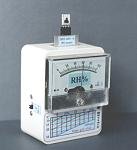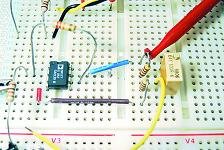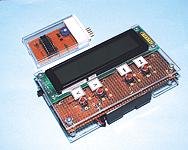
This compact Relative Humidity meter (hygrometer) design uses a new capacitive-type of humidity sensor (the HIH3605) , and has a moving coil meter display to show the % Relative Humidity in your home. Inside is a surface-mount circuit which is fairly straightforward for experienced constructors to build.

![]() PIC Virus
Zapper
PIC Virus
Zapper
Presented entirely and unashamedly for experimental purposes only, this
new design emulates with a PIC microcontroller chip the particular signals
which it is sometimes claimed can help eliminate viruses. The claims of
Dr. Hulda Regehr Clark are also touched upon, with early electronic circuits
also being presented for examination. Judge for yourself. Source code
available for free download from our FTP site.
![]()
![]() In the April
2002 issue (P. 290) we pointed out that on P187 Fig. 7 and in the components
list, the voltage regulator IC1 should be LP2950CZ and not as shown.
In the April
2002 issue (P. 290) we pointed out that on P187 Fig. 7 and in the components
list, the voltage regulator IC1 should be LP2950CZ and not as shown.

How to use Interrupts successfully with your PIC programs. Our new mini series helps you gain a head start by describing the techniques needed when utilising Interrupts with your PIC microcontroller projects. This is not completely straightforward and we explain thoroughly the special considerations you will need to bear in mind.

We continue our ten part educational series with further practical experiments using strain gauges and air pressure sensors. An experimental "weighing machine" is described along with a simple air pressure sensor. Teach-In 2002 discusses many aspects of instrumentation and amplification that won't be found elsewhere in EPE, including lots of new material, so be sure to check out our ten-part series today!

A truly enigmatic idea! This unusual design uses the power of a PIC microcontroller to encrypt and decrypt private messages. The coded message can then be transferred to another Mini Enigma user by means of the data EEPROM of a second PIC, contained in a plug-in module. This produced a coded message system that is very difficult to decrypt. Free source code available from our FTP site.

Now anyone can enjoy the thrill of the sounds of radio broadcasts picked up on a home-built receiver! Our simple two-chip design uses the MK484 chip and an audio amplifier chip to form a complete battery-powered SW receiver. Frequency coverage is several megahertz. Ideal for beginners, every budding constructor will want to build this neat little design.
Also in this issue: Ingenuity Unlimited (readers' own circuit suggestions); New Technology Update describes how superconducting transistors evolved from "astronomical" research; Circuit Surgery discusses the best choice for 9V batteries for your projects.